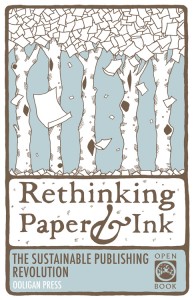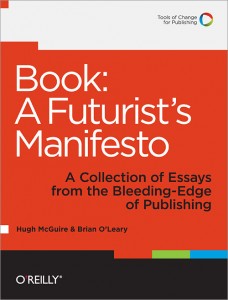I am doing my degree with a minor in Publishing, so I had the chance to read some publishing-related texts this past semester. Here are my (rough) thoughts and musings.

 On the Subject of Literary Criticism:
On the Subject of Literary Criticism:
Considering the topic of literary criticism, and the doom-and-gloom debate of it being a ‘dead art’, I spent an afternoon perusing some books with this theme. I chose to flip through Reading Communities: From Salons to Cyberspace edited by DeNel Rehberg Sedo and Reading the 21st Century by Stan Persky.
Rethinking Paper & Ink: The Sustainable Publishing Revolution
 Part of Ooligan Press’ OpenBook Series, Rethinking Paper & Ink is a detailed look at the different stages of print publishing. The frontmatter of the book contained good transparency regarding it’s own printing process including type of paper and ink used.
Part of Ooligan Press’ OpenBook Series, Rethinking Paper & Ink is a detailed look at the different stages of print publishing. The frontmatter of the book contained good transparency regarding it’s own printing process including type of paper and ink used.
My complaint was that while they did acknowledge the short lifespan of electronics as well as energy required to run devices, it bothered me that they just glossed over e-waste and the toxins it emits. This is a global problem that we in developed nations are creating with our obsession with buying the latest and shiny new gadgets every year. Undeveloped countries are bearing the brunt of our consumerism which can result in toxic chemical leaching into the groundwater, fumes emitted when the electronics are set on fire, and more.
Ooligan Press | April 2011 | ISBN: 978-1932010398 | $21.95
Book: A Futurist’s Manifesto edited by Hugh McGuire & Brian O’Leary
 Book: A Futurist’s Manifesto is a “a collection of essays from the bleeding edge of publishing.” Neat fact: it was created through McGuire’s PressBooks, a free, open source project that turns writing online into ebooks, PDFs, and print-on-demand titles.
Book: A Futurist’s Manifesto is a “a collection of essays from the bleeding edge of publishing.” Neat fact: it was created through McGuire’s PressBooks, a free, open source project that turns writing online into ebooks, PDFs, and print-on-demand titles.
My initial dismay was that several chapters seemed to be self-serving talks about their own projects masquerading as essays about the general topic. I would have preferred them to be presented more as case studies which increases transparency (ie: Travis Alber and Aaron Miller of BookGlutton; Neal Hoskins, WingedChariot). It should be noted that some of the contributors did do this case study style, it just wasn’t properly titled, such as Jurgen Fauth of Fictionaut whose chapter was vaguely titled ‘Communities of Writers’ and Sarah Wendell of Smart Bitches, Trashy Books whose chapter was titled ‘A Conversation That Can’t Be Controlled’.
Reading Kassia Krozser’s chapter, “A Reader’s Bill of Rights”— I felt like it was written by an uninformed consumer complaining about the industry, not someone who has publishing experience (as Krozser’s bio states). Short sections under each Right are neither detailed nor elaborated on, functioning as mere definitions of the subhead. This whole chapter read more like a rant about ebooks than an educated and informative essay. I would have appreciated a more in-depth look at how reader’s rights can help inform publisher’s practices. Also, it was ironic in Krozser’s section she spoke about the Value of Content—including proper editing and formatting—and she had a typo and a formatting error.
I really enjoyed the chapter by the GoodReads founders titled “How Books Get Discovered”. While the graphs were barely readable in the print format, the discussion was detailed and informative. It was interesting that many of the studies show readers discover books through a variety of means, with no one way dominating the others. It’s an important reminder to publishers and authors the need to penetrate multiple markets and platforms when promoting a title. The PressBooks format may have some work to do when it deals with images too, as the figures in this section did not line up with the text that referred to it.
“The Surprising Power of ‘Little Data'” by Peter Collingridge of Bookseer was too frustrating to finish. This chapter relied so much on detailed graphs that I could barely follow along. The figures were very detailed but only printed the width of the finished book. Also, they were in black and white but the text referred to “the blue line” or “the red line”.
I’d suggest reading the essays for free online instead of paying for the print book. I cannot comment on the quality of images and graphs in the ebook.
O’Reilly Media | October 2011 | ISBN: 978-1-4493-0559-8 (ebook) | $9.99 (ebook)
Books as History: The Importance of Books Beyond Their Texts by David Pearson
 I flipped through Books as History for a just short while. It’s a beautifully compiled work, heavily illustrated with archival material.
I flipped through Books as History for a just short while. It’s a beautifully compiled work, heavily illustrated with archival material.
I especially enjoyed the section about margin notes written by notable figures within their own library of books. This is something that we may lose—insight of great minds—with ebooks.
Oak Knoll Press & The British Library | April 2008 | ISBN 9781584562337 | $65.00
Penguin 75: Designers, Authors, Commentary (The Good, The Bad…)
 Created for the 75th anniversary of Penguin Books, Penguin75 features 75 book covers with commentary behind the design process.
Created for the 75th anniversary of Penguin Books, Penguin75 features 75 book covers with commentary behind the design process.
It was lovely to flip through from a designer’s perspective, but from a reader’s perspective, some of the items would be improved from an introductory description of the project (such as the Penguin Poet Series).
Overall though, it was well balanced with commentary from the Art Director(s), Designers, Authors, and (sometimes Illustrators too) for the 75 case studies depicted.





